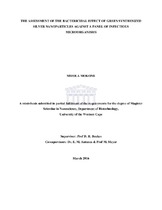| dc.description.abstract | The emergence of multiple drug resistant microorganisms poses a major threat to human life. These microorganisms have made the currently used antibiotics ineffective and therefore continue to thrive. Therefore, there is a need for development of new, broad-secptrum antibiotics which is effective against almost every infectious microorganism. These antibiotics should ensure high effectiveness against the infectious pathogens while it is less detrimental to human health. Thus the search is channelled in nanoscience and nanotechnology in order to develop
antibiotics that can kill infectious microorganisms effectively and hindering the development of drug resistance by these microorganisms. Nanoscience is the study of properties of a material when reduced to it smallest size (below 100 nm). It is a newly developing field of science which includes chemistry, physics and biology and
has made it easy to synthesise nanomaterials for applications in many sectors of life including in medicine. The synthesis of nanoparticles can be achieved by physical and chemical methods. However, these methods are energy and capital intensive. Additionally, chemical method of synthesis uses chemicals that may be toxic which restrict the use of resultant nanoparticles in medicine. Therefore, there is a need for the use of eco-friendly methods of nanoparticle synthesis. The synthesis of silver and gold nanoparticles in this study was carried out by a green synthesis method, at room temperature, using an aqueous extract from the endemic brown alga Sargassum incisifolium. For comparison, commercially available brown algal fucoidans were also used to synthesise these nanoparticle, in addition to conventional methods of synthesis. The formation of nanoparticles was followed by the use of UV-Vis spectrophotometry. The characterization of the
nanoparticles was done by TEM, XRD, DLZ and FT-IR. The rate of nanoparticle formation varied with specific reducing agent used. The faster reaction rate was recorded with S. incisifolium aqueous extracts pretreated with organic solvents while extracts obtained without this pretreatment produced slightly slower reaction rates. However, the commercially available fucoidans were less effective and required elevated temperatures for nanoparticle formation. Sodium borohydride reduction of silver nitrate was faster than the biological methods while the reduction of auric chloride by the S. incisifolium extracts and sodium citrate proceeded at similar rates. The nanoparticles synthesised with the help of the untreated aqueous extract were bigger than those synthesised from pre-treated extracts with both giving irregular shaped of nanoparticles. Also the nanoparticles formed from commercially available fucoidans were not of the same size, with bigger sizes recorded with Macrocystis fucoidan and smaller sizes with Fucus fucoidan.
The shapes of nanoparticles from these fucoidans were spherical. From the conventional method, the nanoparticle sizes were smaller compared to the green synthesised nanoparticles and were predominantly spherical. The silver nanoparticles synthesised from the Sargassum aqueous extracts showed excellent
antimicrobial activity against five pathogenic microorganisms including A. baumannii, K. pneumoniae, E. faecalis, S. aureus, and C. albicans. The gold nanoparticles were much less effective. To adequately assess the antimicrobial activities of the nanoparticles, it is or paramount importance to also asses their cytotoxicity activity. Three cell lines were used in this study namely, MCF-7, HT-29 and MCF-12a. The silver nanoparticles were found to be toxic to HT-29 and MCF-7 cell lines, exhibiting sligtly less toxicity against MCF-12a cells. The gold nanoparticles showed lower toxicity but a similar trend was observed. | en_US |

